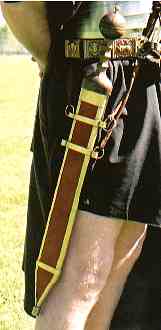|
 On the right side of the soldier's body was a short and relatively lightweight instrument that was his main fighting weapon. The sword gladius On the right side of the soldier's body was a short and relatively lightweight instrument that was his main fighting weapon. The sword gladius
When first examining the gladius, it is difficult to see how such a small weapon, just 18 inches long, was capable of being so effective. But as we shall see the gladius was ingenious in design and implementation.
The soldier wore his gladius on the right side of his body regardless of whether he was left or right handed. As soldiers fought battles not individually, but as a single unit, standing shoulder to shoulder. There would be up to 500 men in a line all touching the one either side, so making it impossible for the enemy top get through the ranks.
 It was imperative that they all used the same hand for fighting with the gladius. So in training, any left handed soldiers would have their left arm strapped to their body and made to practice using his sword with his right hand until it was second nature. It was imperative that they all used the same hand for fighting with the gladius. So in training, any left handed soldiers would have their left arm strapped to their body and made to practice using his sword with his right hand until it was second nature.
When using the gladius, the legionaries did not hack at the opponent as this would have made the soldier vulnerable to attack on the exposed parts of his body. Instead he was trained to stab at the enemy in a very fast back and forth motion. This was most effective as it meant a much faster rate of attack, probably as much as four stabs per second, as opposed to the one slice every two seconds if the gladius was used in a swinging motion.
Wearing it on the right side meant the legionaries could draw his gladius in a very compact manner without interfering with the soldiers on either side of him. Considering the close formation of the Roman battle unit this was a distinct advantage. Having the gladius on the right side meant that it could be drawn without the risk it could be caught up in his shield (Scutum).
|